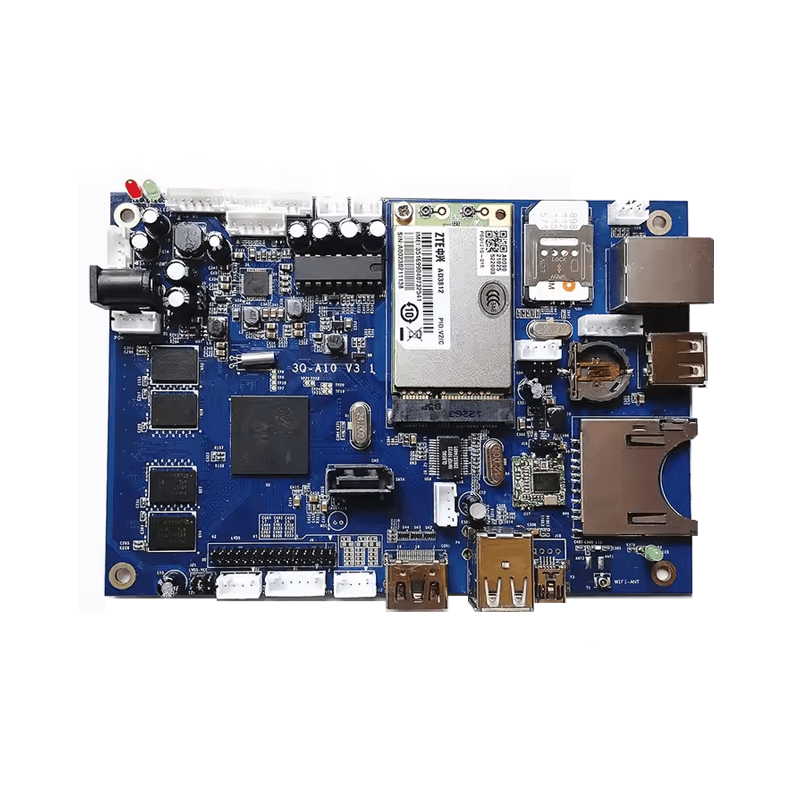Product Parameters
| Base Station Information Board |
| Base Material: |
FR-4 |
| Certification: |
RoHS, ISO |
| Layers: |
Multilayer |
| PCBA QC: |
X-ray, Aoi Test, Function Test(100% Test) |
| Solder Mask Color: |
Green/Black/Red/Blue/Yellow/White/ |
| Min.BGA Space: |
0.3mm |
| Min. Component: |
01005 |
| Name: |
Base Station Information Board PCBA |
Product Display
I. Description
The base station information board is a crucial electronic component used in base station equipment to achieve information collection, processing, and display. It mainly consists of a data acquisition module, microprocessor, storage unit, display control circuit, and display screen. The data acquisition module is responsible for collecting various operating data from all parts of the base station, such as signal - transmitting and receiving devices, power systems, etc., including signal strength, power consumption, equipment temperature, and so on. The microprocessor quickly processes and analyzes the collected data to determine whether the operating status of the base station is normal. The storage unit is used to store historical data for subsequent query and analysis. The display control circuit converts the processed data into appropriate signals and drives the display screen to visually show the key information of the base station, such as real - time operating parameters, fault alarm information, etc., helping maintenance personnel to promptly understand the operating status of the base station.
II. Application Scenarios
- Communication Operator Base Stations: Whether on the top of high - rise buildings in cities or at base station sites in remote mountainous areas, the base station information board plays an important role. The maintenance personnel of operators can view the real - time operating data of the base station through the base station information board, such as signal coverage, communication quality indicators, etc. Once the signal is abnormally weakened or there is equipment failure, the information board will promptly issue an alarm prompt, and the maintenance personnel can respond quickly to ensure the stable operation of the communication network.
- Industrial Internet of Things Base Stations: In the industrial field, the base station information board is used to connect various industrial devices and sensors to achieve centralized data management and transmission. For example, in a smart factory, the base station information board collects the operating data of each device on the production line, such as the operating speed of the equipment, energy consumption, fault early - warning, etc. Through the analysis and display of these data, factory managers can adjust production strategies in a timely manner, optimize equipment operation, improve production efficiency, and reduce production costs.
- Transportation Hub Base Stations: In transportation hubs such as airports, railway stations, and bus stations, the base station information board supports the stability of the communication network. It monitors the operation of the base station in high - traffic and high - communication - demand environments in real - time to ensure that passengers can smoothly use the mobile network for communication, Internet access, etc. during waiting. Once there is network congestion or equipment failure, the information board can provide timely feedback to ensure the communication service quality in the transportation hub area.
III. Hardware Characteristics
- High - speed Data Acquisition: Equipped with a high - performance data acquisition module, it can quickly and accurately collect the operating data of various base station devices. For example, it can complete the acquisition of key data such as signal strength and power in milliseconds, ensuring the real - time nature and accuracy of the data and providing a reliable basis for subsequent data analysis and processing.
- Powerful Data Processing Capability: Adopting an advanced microprocessor, it has powerful computing and processing capabilities. It can quickly analyze and process a large amount of collected data, determine the operating status of the base station, and promptly generate corresponding control commands. For example, in the face of complex network signal changes, the microprocessor can quickly calculate the best signal adjustment strategy to ensure communication quality.
- Large - capacity Storage: It has a large - capacity storage unit that can store a large amount of historical data. These data can be used for subsequent operation trend analysis, fault troubleshooting, etc. For example, it can store the operating data of the base station for several months or even years, facilitating maintenance personnel to review the historical operation of the base station and find potential problems and patterns.
- High - reliability Display: The display screen uses high - brightness and high - contrast materials, which can clearly display the base station information in various environments. At the same time, the display control circuit has good stability and anti - interference ability. Even inside the base station with a complex electromagnetic environment, it can ensure the normal operation of the display screen and accurately display the information. In addition, the display screen also has certain protective properties and can adapt to different working environments.
Only logged in customers who have purchased this product may leave a review.













Reviews